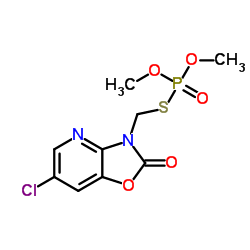Effect of synergists on the oral and topical toxicity of azamethiphos to organophosphate-resistant houseflies (Diptera: Muscidae).
K Saito, N Motoyama, W C Dauterman
Index: J. Econ. Entomol. 85(4) , 1041-5, (1992)
Full Text: HTML
Abstract
Dermal and oral toxicities of azamethiphos were determined in two organophosphate-resistant and one susceptible strain of houseflies, Musca domestica L. The 594vb strain was 1,967-fold more resistant to azamethiphos when compared with the susceptible Chemical Specialties Manufacturers Association (CSMA) strain by dermal application. When the compound was administered orally to the 594vb strain, we observed only a 15-fold resistance. In contrast, the Yachiyo strain, which show 1,500-fold resistance to diazinon and which has known multiple mechanisms for organophosphate resistance, showed only 6-fold resistance to azamethiphos by topical application and 4-fold resistance by oral administration. Azamethiphos administered dermally and orally was equally toxic to the CSMA and Yachiyo strains. However, when azamethiphos was administered to the 594vb strain, the insecticide was 71 times more toxic orally than by the dermal route. This result indicated involvement of a cuticular penetration factor in the resistance mechanism. The effect on azamethiphos toxicity of piperonyl butoxide (PB), an inhibitor of the monooxygenases, and tributylphosphorotrithioate (DEF), an esterase inhibitor, was investigated in the three strains. Pretreatment of the flies with PB, DEF, or PB+DEF before topical application of azamethiphos resulted in a significant decrease in LD50s in all the strains. The degree of synergism, however, varied depending upon the strains and the synergists. Similar results were obtained when azamethiphos was administered orally following pretreatment of the flies with PB+DEF. We attribute the high level of azamethiphos resistance in the 594vb strain partly to increased degradation by oxidative and hydrolytic enzymes. The hydrolytic enzymes are more important, but other factors including reduced cuticular penetration and insensitive acetylcholinesterase may be involved.(ABSTRACT TRUNCATED AT 250 WORDS)
Related Compounds
| Structure | Name/CAS No. | Molecular Formula | Articles |
|---|---|---|---|
 |
Azamethiphos
CAS:35575-96-3 |
C9H10ClN2O5PS |
|
Albumin binding as a potential biomarker of exposure to mode...
2008-06-01 [Biol. Cell 13 , 343-63, (2008)] |
|
Evaluation of insecticidal efficiency of certain new selecti...
1992-12-01 [J. Egypt. Soc. Parasitol. 22(3) , 839-49, (1992)] |
|
Characterisation of esterases as potential biomarkers of pes...
2008-03-01 [Environ. Pollut. 152(2) , 342-50, (2008)] |
|
The lethality of Salmosan (Azamethiphos) to American lobster...
1999-06-01 [Ecotoxicol. Environ. Saf. 43(2) , 165-9, (1999)] |
|
Safety of azamethiphos in eel, seabass and trout.
2004-02-01 [Pharmacol. Res. 49(2) , 171-6, (2004)] |